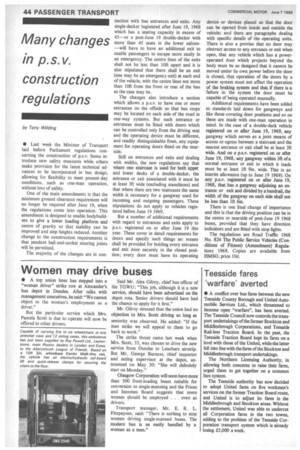Many changes in p.s.v.
Page 46

If you've noticed an error in this article please click here to report it so we can fix it.
construction regulations
by Tony Wilding • Last week the Minister of Transport laid before Parliament regulations concerning the construction of p.s.v. Some introduce new safety measures while others make provision for the latest technical advances to be incorporated in bus design, allowing for flexibility to meet present-day conditions, such as one-man operation, without loss of safety.
One of the main amendments is that the minimum ground clearance requirement will no longer be required after June 19, when the regulations come into operation. This amendment is designed to enable bodybuilders to give a lower loading platform and centre of gravity so that stability can be improved and step heights reduced. Another change to the construction requirements is that pendant ball-and-socket steering joints will be permitted.
The majority of the changes are in con
nection with bus entrances and exits. Any single-decker registered after June 19, 1968 which has a seating capacity in excess of 45—or a post-June 19 double-decker with more than 45 seats in the lower saloon-will have to have an additional exit to enable passengers to escape more easily in an emergency. The centre lines of the exits shall not be less than 10ft apart and it is also stipulated that there shall be an exit (one may be an emergency exit) at each end of the vehicle, with the centre lines not more than 10ft from the front or rear of the bus as the case may be.
The changes also introduce a section which allows a p.s.v. to have one or more entrances on the offside so that bus stops may be located on each side of the road in one-way systems. But such entrance or entrances must be fitted with doors which can be controlled only from the driving seat and the operating device must be different, and readily distinguishable from, any equipment for operating doors fitted on the nearside,
on entrances and exits and dealing with widths, the new regulations say that where one staircase is used for both upper and lower decks of a double-decker, the entrance or exit associated with it must be at least 3ft wide (excluding stanchions) and that where there are two staircases the same width is necessary for a gangway used for incoming and outgoing passengers. These stipulations do not apply to vehicles registered before June 19 1969.
But a number of additional requirements with regard to entrances and exits apply to p.s.v. registered on or after June 19 this year. These cover in detail requirements for doors and specify such things as: means shall be provided for holding every entrance and exit door securely in the closed position; every door must have its operating device or devices placed so that the door can be opened from inside and outside the vehicle; and there are paragraphs dealing with specific details of the operating units. There is also a proviso that no door may obstruct access to any entrance or exit when open, that any vehicle which has a poweroperated door which projects beyond the body must be so designed that it cannot be moved under its own power before the door is closed, that operation of the doors by a power system must not affect the operation of the braking system and that, if there is a failure in the system the door must be capable of being operated manually.
Additional requirements have been added to standards laid down for gangways and like those covering door positions and so on these are made with one-man operation in mind. In the case of a double-deck vehicle registered on or after June 19, 1969, any gangway which serves as a joint means of access or egress between a staircase and the nearest entrance or exit shall be at least 3ft wide. And on a p.s.v. registered on or after June 19, 1968, any gangway within 3ft of a normal entrance or exit to which it leads must be at least 1ft 9in. wide. This is an interim allowance (up to June 19 1969). On any p.s.v. registered on or after June 19, 1968, that has a gangway adjoining an entrance or exit and divided by a handrail, the width of the gangway on each side shall not be less than lft 6in.
There is one final change of importance and this is that the driving position can be in the centre or nearside of post-June 19 1968 buses, provided that they have direction indicators and are fitted with stop lights.
The regulations are Road Traffic 1968 No. 824 The Public Service Vehicles (Conditions of Fitness) (Amendment) Regulations 1968. Copies are available from HMSO, price 10d.
















































































































































